List of Sites of Special Scientific Interest in Bedfordshire
Bedfordshire is a county in the East of England.[1] It is bounded by Hertfordshire to the south-east, Cambridgeshire to the north-east, Northamptonshire to the north, and Buckinghamshire to the west.[2] It has an area of 1,235 square kilometres (477 sq mi), and population estimated in 2015 at 630,000, with an increase of 10% over the previous ten years.[3] The county town is Bedford, and the name is first recorded in the treaty in about 879 between King Alfred the Great and Guthrum, which divided English and Danish territory by a line which went through Bedford.[4]
Southern Bedfordshire is part of the Chilterns Area of Outstanding Natural Beauty. North and mid Bedfordshire are undulating claylands with broad river valleys of the River Great Ouse and its tributaries, and the Bedfordshire Greensand Ridge. Jurassic and Cretaceous clays are overlaid by Quaternary glacial deposits of chalky boulder clay.[5]
There are forty Sites of Special Scientific Interest (SSSIs) in Bedfordshire, designated by Natural England. Thirty-five are listed for their biological interest, and five for their geological interest.[6] Three of the sites are also National nature reserves, twelve are in the Chilterns Area of Outstanding Natural Beauty, and eleven are managed wholly or partly by the Wildlife Trust for Bedfordshire, Cambridgeshire and Northamptonshire. In 2009 Bedfordshire was divided into three unitary local authorities: thirty-two sites are in Central Bedfordshire, eight in Bedford and none in Luton.
For other counties, see List of SSSIs by Area of Search.
Key
Interest
- B = a site of biological interest
- G = a site of geological interest
Other classifications
- CAONB = Chilterns Area of Outstanding Natural Beauty
- GCR = Geological Conservation Review
- LNR = Local nature reserve
- NCR = A Nature Conservation Review
- NNR = National nature reserve
- NT = National Trust
- RHPG = Register of Historic Parks and Gardens of Special Historic Interest in England
- RSPB = Royal Society for the Protection of Birds
- SM = Scheduled Monument
- WT = Woodland Trust
- WTBCN = Wildlife Trust for Bedfordshire, Cambridgeshire and Northamptonshire
Sites
See also
Notes
References
- ↑ "East of England". Office for National Statistics. Retrieved 9 December 2015.
- ↑ "Your Guide to the Counties of England". Counties in England. Retrieved 9 December 2015.
- ↑ "Bedfordshire Police". Her Majesty's Inspectorate of Constabulary. Retrieved 9 December 2015.
- ↑ Page, William, ed. (1912). A History of the County of Bedford 3. London: Victoria County History. p. 1.
- ↑ "Bedfordshire and Cambridgeshire Claylands". National Character Area profile. Natural England. Retrieved 10 December 2015.
- ↑ "Designated Sites View: SSSIs Bedfordshire". Natural England. Retrieved 29 December 2015.
- 1 2 3 "Bedfordshire's National Nature Reserves". Natural England. Retrieved 24 August 2015.
- 1 2 "Barton Hills citation" (PDF). Sites of Special Scientific Interest. Natural England. Retrieved 24 August 2015.
- ↑ "Biddenham Pit citation" (PDF). Sites of Special Scientific Interest. Natural England. Retrieved 24 August 2015.
- ↑ "Blow's Downs". Wildlife Trust for Bedfordshire, Cambridgeshire and Northamptonshire. Retrieved 24 August 2015.
- ↑ "Blows Downs Nature Reserve". Wildlife Extra. Retrieved 10 December 2015.
- ↑ "Coopers Hill - Bedfordshire SSSI". Local Nature Reserves. Natural England. 18 February 2013. Retrieved 24 August 2015.
- ↑ "Cooper's Hill". Wildlife Trust for Bedfordshire, Cambridgeshire and Northamptonshire. Retrieved 24 August 2015.
- ↑ "Pegsdon Hills and Hoo Bit". Wildlife Trust for Bedfordshire, Cambridgeshire and Northamptonshire. Retrieved 24 August 2015.
- ↑ "Map of Deacon Hill". Sites of Special Scientific Interest. Natural England. Retrieved 24 August 2015.
- ↑ "Cycling in the Chilterns". Ordnance Survey. Retrieved 10 December 2015.
- ↑ "Double Arches Pit citation" (PDF). Sites of Special Scientific Interest. Natural England. Retrieved 25 August 2015.
- ↑ "Dropshort Marsh". Wildlife Trust for Bedfordshire, Cambridgeshire and Northamptonshire. Retrieved 25 August 2015.
- 1 2 "Dunstable Downs and Whipsnade Estate". National Trust. Retrieved 10 December 2015.
- ↑ "Fancott Woods and Meadows". Wildlife Trust for Bedfordshire, Cambridgeshire and Northamptonshire. Retrieved 25 August 2015.
- ↑ "Felmersham Gravel Pits". Wildlife Trust for Bedfordshire, Cambridgeshire and Northamptonshire. Retrieved 26 August 2015.
- ↑ "Flitwick Moor (& Folly Wood)". Wildlife Trust for Bedfordshire, Cambridgeshire and Northamptonshire. Retrieved 26 August 2015.
- 1 2 "Galley and Warden Hills SSSI". Local Nature Reserves. Natural England. 18 February 2013. Retrieved 10 December 2015.
- ↑ Wildlife Trust for Bedfordshire, Cambridgeshire and Northamptonshire (January 2015). "A Nature Conservation Strategy for Central Bedfordshire" (PDF). Central Bedfordshire Council. pp. 27–28. Retrieved 23 August 2015.
- ↑ "Luton, Dunstable & Houghton Regis local transport plan 2006-2011" (PDF). Bedfordshire County Council. p. 18. Retrieved 10 December 2015.
- ↑ "Kensworth Chalk Pit". British Upper Cretaceous Stratigraphy (PDF). Joint Nature Conservation Committee. 2001.
- ↑ "Kensworth Parish Green Infrastructure Plan" (PDF). Bedfordshire Rural Communities Charity. Retrieved 10 August 2015.
- ↑ "Kings and Bakers Woods and Heaths citation" (PDF). Sites of Special Scientific Interest. Natural England. Retrieved 27 August 2015.
- ↑ "King's Wood and Rammamere Heath". Wildlife Trust for Bedfordshire, Cambridgeshire and Northamptonshire. Retrieved 27 August 2015.
- ↑ "Kings Wood and Glebe Meadows, Houghton Conquest". Local Nature Reserves. Natural England. 18 February 2013. Retrieved 23 August 2015.
- ↑ "Knocking Hoe citation" (PDF). Sites of Special Scientific Interest. Natural England. Retrieved 8 March 2015.
- ↑ "Knocking Hoe National Nature Reserve". Chilterns Conservation Board. Retrieved 8 March 2015.
- ↑ "Marston Thrift". Local Nature Reserves. Natural England. 18 February 2013. Retrieved 23 August 2015.
- ↑ "Maulden Church Meadow". Local Nature Reserves. Natural England. 18 February 2013. Retrieved 24 August 2015.
- ↑ "Nine Acres Pit citation" (PDF). Sites of Special Scientific Interest. Natural England. Retrieved 28 August 2015.
- ↑ "Sandy Warren citation" (PDF). Sites of Special Scientific Interest. Natural England. Retrieved 28 August 2015.
- 1 2 "Smithcombe, Sharpenhoe and Sundon Hills citation" (PDF). Sites of Special Scientific Interest. Natural England. Retrieved 28 August 2015.
- ↑ "Sharpenhoe". National Trust. Retrieved 28 August 2015.
- ↑ "Southill Park". Historic England. Retrieved 31 August 2015.
- ↑ "Sundon & Streatley Chiltern Arc, Access & Green Space Vision Plan" (PDF). Central Bedfordshire Council. 2013. pp. 8–9. Retrieved 31 August 2015.
- ↑ "Swineshead Wood citation" (PDF). Sites of Special Scientific Interest. Natural England. Retrieved 1 September 2015.
- 1 2 3 "Totternhoe Knolls". Chilterns Conservation Board. Retrieved 10 December 2015.
- 1 2 "Totternhoe". Wildlife Trust for Bedfordshire, Cambridgeshire and Northamptonshire. Retrieved 9 September 2015.
- ↑ "Totternhoe Knolls". Local Nature Reserves. Natural England. 9 February 2013. Retrieved 9 September 2015.
- ↑ "Totternhoe Stone Pit citation" (PDF). Sites of Special Scientific Interest. Natural England. Retrieved 6 September 2015.
| Wikimedia Commons has media related to Sites of Special Scientific Interest in Bedfordshire. |
Coordinates: 52°05′N 0°25′W / 52.083°N 0.417°W
| ||||||||||||||||||
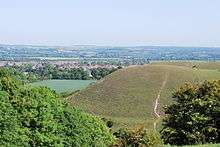



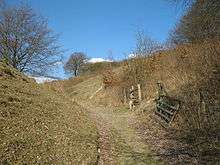
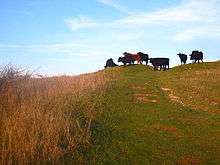
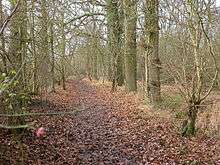

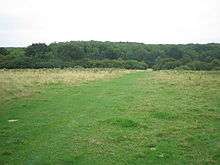

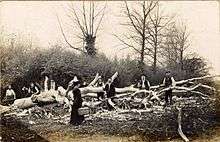



.jpg)


